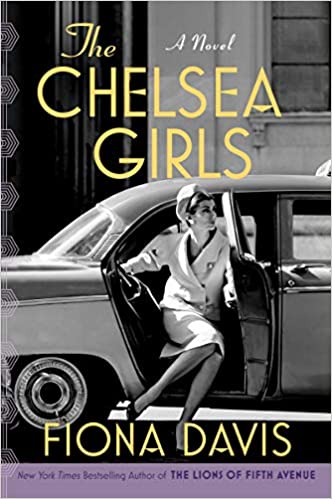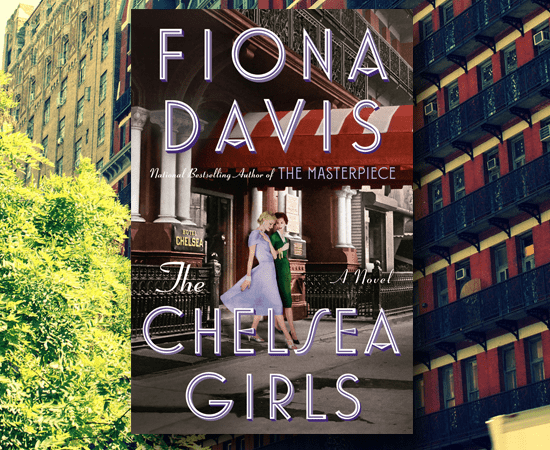The Chelsea Girls by Fiona Davis
In Fiona Davis’ The Chelsea Girls (Dutton), the shy cerebral Hazel Ripley and flamboyant Maxine Mead are thrown together for a USO performance in Naples, Italy, during World War II. They hate each other at first sight. Maxine regularly brings down the house while Hazel, whose reputation as a perpetual understudy has followed her from Broadway, hopes she will never have to take the stage. It is unlikely that the two women will become best friends, yet they do.
Running an errand, they stumble on an ugly confrontation between a mob and two boys who have been accused of being German spies. The boys insist that they work for the Italian Resistance. Maxine and Hazel believe them and intervene with the police. Out of their effort comes an invitation by the American brass to create a propaganda radio show that will be broadcast to a German audience. Hazel and Maxine, who is fluent in German, become a team – and confidantes to boot. But they don’t share everything.
After the war, Maxine heads to California where she hopes to become a star, and Hazel, working in radio and living unhappily with her parents, decides to move to the Chelsea Hotel on West 23rd Street. She recalls Maxine describing her happy memories of living at the Gilded Age hotel, located in what was once the city’s theater district. Now it is 1950. The cast of characters who occupy the spacious rooms with balconies and fireplaces are eccentric, artistic, and leftwing, as has always been the case.
Fiona Davis, whose most recent book, The Masterpiece, wove a tale around Grand Central Terminal during the 1930s, knows how to write about missed connections and deep dark secrets. Her gift is to transform an iconic building into a character in her story, whether the Dakota apartment building (The Address), the Barbizon Hotel (The Dollhouse) or, in this case, the Chelsea Hotel.
As Hazel sets out to write her first play, the two boys accused of being German spies seem far in the past. Yet their plight resonates in the present. The McCarthy era has just begun, terrorizing Hollywood and the stage (among many professions) with accusations and interrogations. McCarthyism threatens the friendship between Hazel and Maxine, testing loyalty, morality, and honesty. In The Chelsea Girls, Fiona Davis tackles a new place and time with historical accuracy and a plot full of surprises.
We had the opportunity to speak with Fiona Davis about her novel:
Which came first – wanting to set a novel in the Chelsea Hotel or wanting to write about the McCarthy era?
The idea for the location came first, as I loved the architecture of the building and the way its legendary status afforded it a kind of dirty mystique. However, the more I dug in, the more I became intimidated by the sheer number of brilliant artists who passed through the doors over multiple decades, not to mention their wide variety of vocations. Where on earth to start? The decision to set the novel during the McCarthy era came later, once I realized who my main character would be, and that helped me narrow down my focus to Broadway actors in the 1950s.
You’ve mentioned that Hazel’s character was inspired, in part, by Lillian Hellman. Did you model the main characters – Hazel and Maxine – after anyone else in particular?
Hazel’s plotline is definitely drawn from Lillian’s legendary appearance before the House Un-American Activities Committee in 1952, but the character was first and foremost inspired by the late actress Virginia Robinson. Robinson, who passed away last year at the age of 99, shared delicious stories with me about being on the USO Tour in WWII and working in New York theater. During one of our conversations, she mentioned terms I wasn’t familiar with, like “Red Channels” and “loyalty oaths” and became incensed as she realized I had no idea what she was talking about. Practically spitting in anger, she set me straight regarding the damage the blacklist had done to her and her fellow performers. Once I knew the facts, I felt compelled to include an exploration of the McCarthy era in the novel. In terms of physical appearances, Hazel is inspired by Grace Kelly and Maxine is modeled after an actress name Rhonda Fleming – I kept photos of them above my desk to refer to as I wrote.
In the book, one of the characters describes the hotel as “quite a stew.” Does the hotel itself maintain good records of guests and residents or did you look elsewhere for details about the “stew”?
The former manager, David Bard, and his son, Stanley, were notorious for not keeping proper records. Often, the long-term residents simply had a verbal agreement with the Bards, or paid for their rent in artwork. Luckily for me, Sherrill Tippins’s book Inside the Dream Palace is a beautifully researched and written non-fiction account of the hotel’s history, and that became my bible. She did a ton of legwork that made my job of writing a fictional account of the hotel much easier, and was very generous in sharing her research. Many former residents have written first-hand accounts of their lives at the Chelsea – for example, Arthur Miller’s essay The Chelsea Affect – and those were valuable as well.
So much of The Chelsea Girls is theater – not only Hazel’s play but also the performances of the men and women called before the McCarthy Committee. In addition to the books that you read for background on McCarthyism, did you pursue any archival research for the book?
I love the way you put that – that both are theatrical performances. Exactly right. For the political thread of the book, I watched recordings of the HUAC committee meetings to get a sense of the setting and the individuals involved, and read transcripts from the hearings. In terms of researching the Broadway theater world, I toured the Samuel J. Friedman theater (formerly the Biltmore) from the basement to the top-floor dressing rooms, which was a treat. I also spent a lot of time digging through archives at the New York Public Library for the Performing Arts to learn more about the USO Tour during WWII. They had boxes and boxes filled with items like actor handbooks and letters home describing the rigors of the job, which were helpful in recreating that particular time and place.
I can’t not ask you this: where next?
I’m working on a manuscript that’s set in the New York Public Library in 1913 and 1993. It’s a magnificent building, of course, but I’m learning all kinds of fascinating details about the various nooks and crannies, including the fact that the superintendent lived with his family in a seven-room apartment inside the library starting in 1911. That was just too tempting to pass up.
The Chelsea Girls is now available.
MORE FIONA DAVIS
Fiona Davis’s The Lions of Fifth Avenue: A New York City Mystery of History
The Masterpiece: NYC’s Grand Central as One of the Stars
The Address: Author Fiona Davis Shares the Secrets to Her Writing Success
MORE ON THE CHELSEA GIRLS
Find out what Jennifer Blankfein thought of this book on her Book Nation by Jen blog.
Buy this Book!
Amazon




